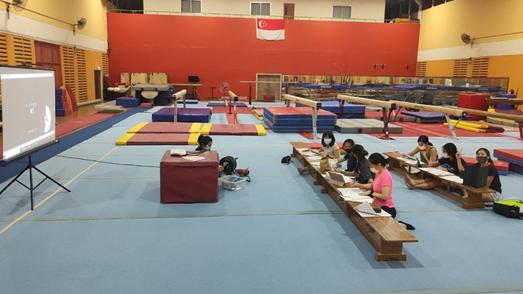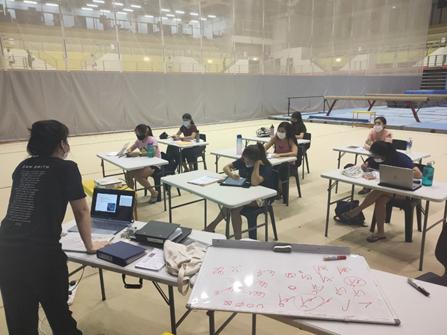
6 minute read
Judge Education and Development
Grow the number and capability of the Gymnastics workforce made up of coaches, volunteers and administrators judges,
Singapore Gymnastics has continued to work hard over the past year to address the perceived intentional biases and unintentional judging errors that occur in competitions. These questions are in response to feedback we received from our Annual Survey of the community, from Club Visits, as well as specific issues raised through our Technical Advisory Councils, and tabled at the 2020 Annual General Meeting.
The key strategies have been:
Source and implement a new scoring system which can support all our disciplines, and which can be used to track judge scores, scoring trends and judging quality at SG events.
Review the judge education framework to ensure appropriate levels of judges throughout the system, as well as increase the numbers of judges overall.
Be transparent in the allocation of judges in competition.
Provide professional development sessions to improve judging competency.
Despite the 2020 National Championships and Singapore Open being cancelled, all these strategies have either been achieved or made significant progress (limited only by the lack of competitions).
New Scoring System
The initial step was the adoption of ScoreExpress as our competition scoring system. There were two primary requirements during the sourcing of a scoring system:
That the one system can support all our disciplines
That the scoring can be linked back to individual judges for review
Based on its ability to deliver both of these requirements, SG committed to a one-year trial of this system.
The first phase of scoring analysis is aiming to address perceived improprieties is threefold:
Look at the data for overall trends, regardless of the judge
Develop education sessions to address areas requiring improvement
Use these first two points to ensure all judges know scoring is now being reviewed in competitions.
The following areas were analysed:
Amount of time a judge’s score was eliminated as the highest score
Amount of time a judge’s score was eliminated as the lowest score
Amount of time a judge’s score was 0.6 above or below the final score
Amount of time a judge’s score was 1.0 above or below the final score
Amount of time a judge’s score was 1.5 above or below the final score.
All judges were included in this analysis for Levels competitions as all judges were assessing the compulsory skills, based on the SG National Programme. With Stages and FIG divisions, only Execution Technical judges were included.
It is very important to note that, as this is the first time this analysis is being done, there is no clear idea of exactly what is good or bad yet. This will build over time.
After analysing through the all the data, it was decided to focus primarily on variation in routine scores.
Total Routines 0.6 Variation 1.0 Variation 1.5 Variation
RGLevel1 _ 6-7 years
RGLevel1 _ 8 years
RGLevel1 _ 9 years
RGLevel3 _ 11-12 years
RGLevel5 _ 13+ years 344 37 67 51 130 33
Total
366 63 60 48 88 81
%
106% 170% 90% 94% 68% 245%
Total
86 8 8 8 8 30
%
25% 22% 12% 16% 6% 91%
Total
16 2 0 2 5 7
% 5% 5% 0% 4% 4% 21%
The data above is for Levels divisions of RG with more than 20 routines judged. The total number of routines is listed, along with the number of routines in the selected divisions. The number of judge total deductions which were more than 0.6 (and 1.0, 1.5) different from the calculated total deductions are noted in the following columns. That is, if the calculated total deduction was 4.1, a judge’s deduction of 3.4 or 4.8 would be more than 0.6 different.
The standouts from this analysis are:
All panels had 6-8 judges all judging exactly the same thing, therefore they can be compared directly
To put the numbers in practical terms, a 0.6 variation of 100% means that in every routine, 1 judge had a deduction that was 0.6 or more different to the final deduction given.
Level 1 6-7, and Level 5 have 0.6 variations much higher than the overall Levels
Level 5 was the final session of the event, which may have had an impact due to fatigue
Further investigation will be ongoing in future events
Future Plans
The primary focus for the future, based on this data, is to decrease the amount of variation. This means our judges will be more consistent and cohesive.
Based on the analysis, the following plans for judge professional development sessions have been identified:
Practice Sessions for National Judges to practise judging and keep abreast of pertinent updates to be organised quarterly each year
Collection of Feedback from Head Judge upon completion of each competition session to allow for collation of specific issues encountered, if any.
Transparency in Judge Allocation Allocation for Artistic panels focused on pairing an experienced and inexperienced judge. The allocation is done by the Head Judge in consultation with the TAC and, where appropriate, the Programme Manager.
Allocation for RG judging panels, the RG TAC has identified that there is still a need for FIG accredited local judges to helm the Difficulty panels, and where possible, allocate at least 1 FIG accredited judge to both the Artistic Execution panel and the Technical Execution panel, respectively. Relying on the experiences of the FIG accredited local judges allow for the less experienced national judges to gain insight on the intricacies of the judging at a higher level. The deliberate pairing as such will allow mentorship and guidance to take place during opportunities of judging at competitions as well as control testing.
Judging Framework
After a review of the current judging framework, a Level 3 Judging Course has been added for Artistic Gymnastics.
WAG Level 1 Judges Course (February 2021)
The third Women’s Artistic Gymnastics Level 1 Judging course (using the WAG National Program 2019 – 2024) was held on 20, 24, 25, and 27 February 2021.
Many of the participants were retired / retiring gymnasts and coaches. The course touched on the basic principles of judging, general rules as well as the specific rules on the various apparatus. One participant commented “It is interesting to now see a routine with a different eye” .
On the last day of the course, participants had to pass a theory exam and a practical exam before receiving National Level 1 judge accreditation. We are pleased to announce that we now have 8 new National Level 1 judges.
WAG Level 2 Judges Course (January 2021)
Singapore Gymnastics held the inaugural Women’s Artistic Gymnastics Level 2 Judging course (using the WAG National Programme 2019 – 2024) on 20, 21, 23, and 29 January 2021.

Seven participants went through a very intense 3 days of training, where the various presenters shared the technical information of the 4 apparatus as well as the general rules that cover all 4 apparatus.
It was a great opportunity for the judges to revisit the routines and have more practice in judging routines in preparation for the National Championships in March. We strive to continuously maintain the highest standards of judging and look forward to having more judges come through our judging courses.
RG Level 1 Judges Course (February 2021)
Spanning 3 weekends in February 2021, the annual RG SG Judges Course was conducted by FIG accredited Brevet 4 Judge and Technical Advisory Council Judging Coordinator, Ms Phaan Yilin. This year, the Level 1 course was attended by 12 participants, abiding by SafeManagement Measures in line with the COVID-19 restrictions. Out of the 12 attendees, 10 passed the exam and became accredited Level 1 judges.
TRA Level 1 and Level 3 Judges Course (Feb 2021)
The annual TRA SG Level 1 and 3 Judges Courses was conducted in February 2021 attended by 2 and 3 participants respectively, of which, 100% pass rate was achieved for TRA Level 1 Judges and 67% pass for TRA Level 3 Judges. SG is grateful to have had Brevet judge and Technical Advisory Council Judging Coordinator, Lee Kern Choong, helm and conduct both courses, alongside with Louis Ang, who acted as an understudy.










